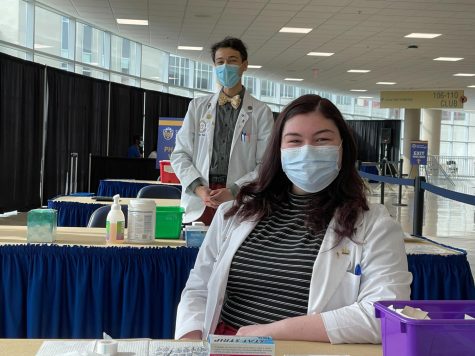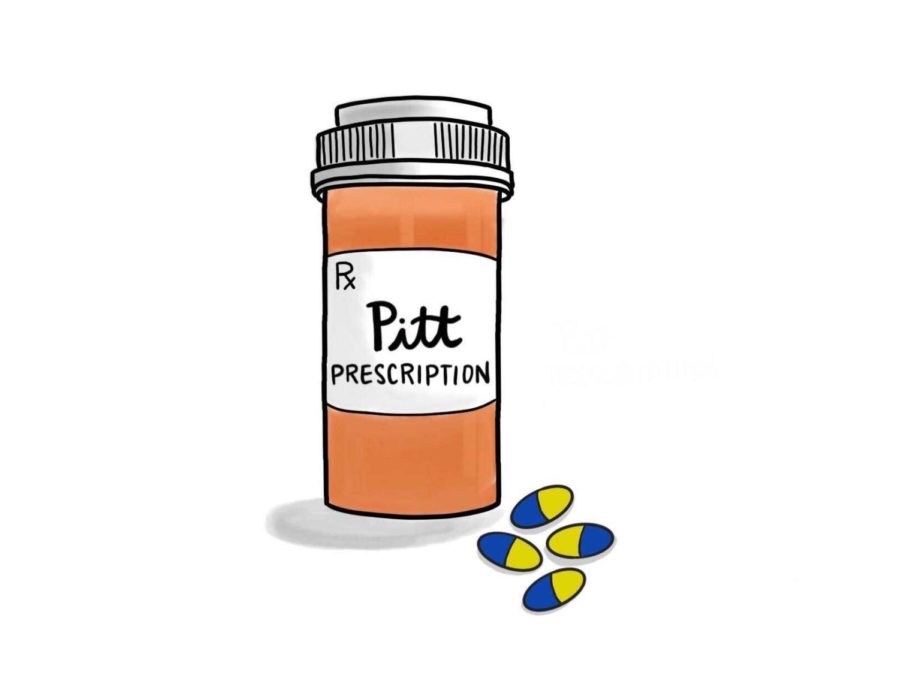The Pitt Prescription | Bivalent COVID boosters: Your best shot at preventing illness
The Pitt Prescription is a biweekly blog where student pharmacist and senior staff writer Elizabeth Donnelly provides tips on how to stay healthy in college. This edition was reviewed by Karen Pater, PharmD., CDCES, BCACP.
Shruti Talekar | Contributing Editor
The Pitt Prescription
September 25, 2022
The month of October marks the onset of fall and all of its wonderful attributes — cooler weather, pumpkin patches, spooky season and more. However, it also marks the beginning of cold and flu season. With COVID-19 also thrown into the mix — infecting around 50,000 people daily — experts recommend getting your annual flu shot and an updated COVID-19 booster this fall.
Flu shots have been around for decades — since the 1940s, to be exact — and they have consistently been proven to prevent severe disease due to the influenza virus. For the 2019-20 flu season, the Centers for Disease Control and Prevention estimates that flu shots prevented about 7.5 million infections, 3.7 million medical visits, 105,000 hospitalizations and 6,300 deaths due to flu. Flu shots are both safe and effective, and two previous editions of The Pitt Prescription have covered them in-depth. Read about misconceptions related to flu shots here or how to navigate flu season here.
Flu shots are not the only vaccine available to the public this fall — the newly formulated bivalent COVID-19 booster shots are also on the market. These new Moderna and Pfizer boosters are available to any individuals who have completed their primary series, either the 2-dose mRNA vaccines or the single dose vaccine.
Bivalent vaccines are not a new concept — they are just vaccines with multiple components rather than just one (aka monovalent). When a vaccine is labeled as “bivalent,” it just means there are two strains of the virus targeted with said vaccine. The same can be said for our annual flu shots, which used to be trivalent, meaning that they worked against three strains of the flu virus, but are now quadrivalent, targeting four.
As time goes on, vaccines are often augmented to target the most prevalent viral strains. The new bivalent COVID vaccines have activity to fight against both the original strain of SARS-CoV-2 as well as the newer and more prevalent BA.4/BA.5 omicron variant. Over time, with the constant mutation of the original virus, the monovalent original vaccines became less effective at fighting against severe illness. However, they still provide a great immune response to the original, more deadly strain of COVID.
With the bivalent vaccine added onto the original series as a booster, this allows the body to form the best possible antibodies to the currently circulating variants. The BA.4/BA.5 Omicron strains are the most prevalent viruses affecting the U.S. currently, and scientists predict they will cause the majority of the cases this fall and winter. Because of this, experts suggest getting boosted against COVID-19 by the end of October, recommending to get both the bivalent booster and the annual flu shot.
If you have had COVID-19 recently, Pitt’s COVID-19 Medical Response Office recommends waiting about two months before getting your booster since your body will have naturally acquired antibodies against COVID for roughly that duration of time. After about two to three months, the antibodies formed from a COVID-19 infection tend to dissipate and individuals are more susceptible to re-infection. Additionally, for anybody who has recently gotten their primary series of the COVID-19 vaccine (aka only one or two shots of the Moderna or Pfizer monovalent vaccine), the CDC recommends waiting two months to get the bivalent booster.
In a press briefing, White House COVID-19 Response Coordinator Dr. Ashish Jha said, “The good news is you can get both your flu shot and COVID shot at the same time. It’s actually a good idea. I really believe this is why God gave us two arms — one for the flu shot and the other one for the COVID shot.”
There are several opportunities to get both your COVID-19 bivalent booster as well as the annual flu shot around campus. To start, there are many community pharmacies, like the Rite Aid or CVS on Forbes Avenue that offer online appointment scheduling services to help patients sign up for the flu shot and COVID-19 booster.
Even more convenient and centrally located is Pitt’s own vaccination center — the Pitt Vaccination and Health Connection Hub located next to the University Pharmacy at the base of Nordenberg Hall. The Hub allows for all Pitt staff, faculty and students to get updated COVID-19 boosters and flu vaccines. They strongly recommend making an appointment for your vaccines. However, walk-ins are accepted and they do their best to accommodate all individuals interested in getting a flu shot or COVID booster.

(Image courtesy of Elizabeth Donnelly)
The Hub is also offering some mass vaccination clinics at the Petersen Events Center and William Pitt Union, so be on the lookout for those as well. The next one offering flu shots is scheduled for Oct. 4 from 10 a.m. to 2 p.m.
Students not located on campus can find other options using the Allegheny County Health Department’s official vaccine provider map. UPMC also offers its own vaccine scheduling system, so any interested students can check out this platform as well.
Fall 2022 Pitt Vaccination Center Hours
Mondays: noon – 7 p.m.
Tuesdays: noon – 5 p.m.
Wednesdays: 10 a.m. – 4 p.m.
Thursdays: noon – 7 p.m.
Fridays: noon – 5 p.m.
Elizabeth writes primarily about self-care and pharmacological topics. For questions, comments or concerns, you can reach her at [email protected].








